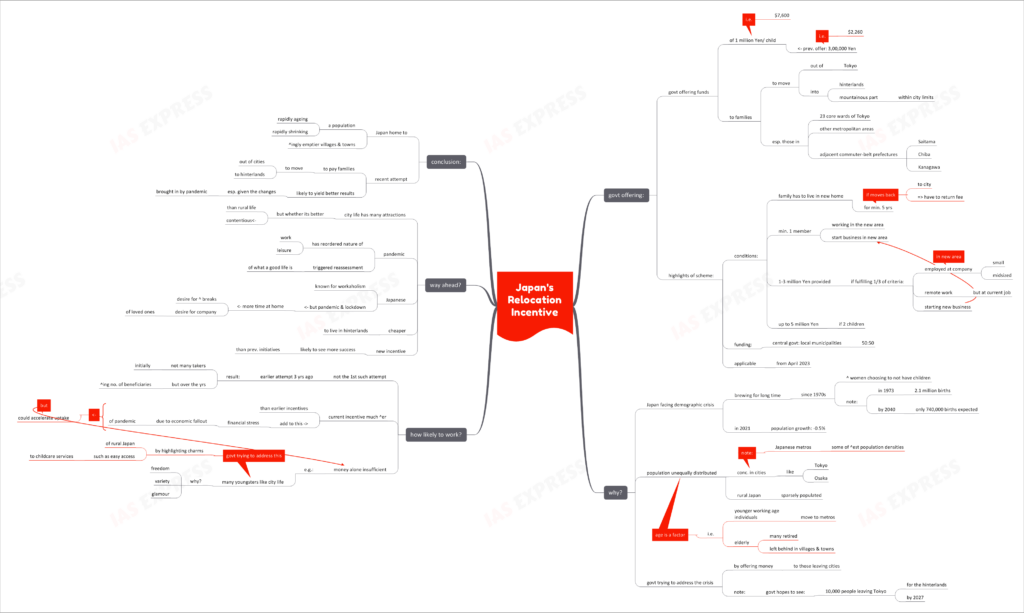Japan’s Relocation Incentive- Highlights & Reasons

The Japanese government is offering 1 million Yen/ child to young families that move to the less crowded parts of Tokyo and the hinterlands of the island nation.

What is the Japanese government offering?
- The government is offering 1 million Yen (working out to $7,600)/child to families that move out of the crowded parts of Tokyo. This is a significant increase from the previously offered 3,00,000 Yen (about $2,260).
- This incentive is targeted at the people currently residing in the 23 core wards of Tokyo, other metropolitan areas and the adjacent commuter-belt prefectures (Saitama, Chiba and Kanagawa).
- The incentive is offered to those families that move to the hinterlands and even the mountainous areas within the city limits.
- The families are to live in their new homes for a minimum period of 5 years.
- At least one member of the family has to work in the area or start a business there.
- Specifically, the families can avail 1-3 million Yen if they fulfil any one of the 3 criteria:
- Employed at a small/ mid-sized company in the new area
- Retaining current job but via remote working
- Starting a business in new area
- Apart from this, families with 2 children are eligible for up to 5 million Yen.
- If a family were to move out of the metropolitan areas, take the incentive and then move back to the city, it is to return the fee.
- When it comes to funding, the central government and the local municipalities contribute 50:50.
- This new fee is to be applicable from April 2023 onwards, in a country that is seeing its population decline in areas other than the urban centres.
Why is it doing so?
- Japan’s demographic crisis has been brewing for a long time now.
- Since the 1970s, Japanese women have been increasingly choosing to not have children. For instance, there were 2.1 million births in 1973. By 2040, the number births is expected to fall to 740,000.
- In 2021, the country had a population growth rate of -0.5%.
- Even this shrinking population is concentrated in metro centres like Tokyo and Osaka. Interestingly, these Japanese metros have some of the highest population densities in the world. Meanwhile, rest of Japan is sparsely populated.
- One factor contributing to this distribution is age- the younger working age individuals move to the metros, while the elderly are left behind in the hinterlands. As a result, the Japanese towns and villages are seeing a declining population rate.
- The government has been trying to address this crisis by offering money to those choosing to leave the big cities. Through this latest incentive, the Japanese government hopes to see 10,000 people leaving Tokyo for the hinterlands by 2027.
How likely is it to work?
- This isn’t the 1st such relocation incentive being offered by the Japanese government. This was first launched 3 years ago.
- Initially, such incentives didn’t have much takers. However, the number of beneficiaries has been increasing over the years.
- Also, the current incentive is a significant increase from the earlier sums. Adding to this is the economic fallout of the pandemic and the lockdowns, resulting in a financial strain on the families. Hence, it could accelerate the uptake of this scheme.
- However, money alone is insufficient to entice people to give up the city life. For instance, many youngsters enjoy the Japanese metro cities’ freedom, variety and glamour.
- In an attempt to get people to move to the hinterlands, the government has been trying to highlight the charms of rural Japan, such as easy access to childcare services, to the city-dwellers.
What is the way ahead?
- While the city life has its many attractions, whether it is better than rural life is contentious.
- The pandemic has reordered the nature of work and leisure across the world. It has triggered a reassessment of what the ‘good life’ is.
- The Japanese are known for their workaholism. However, with the start of the pandemic, the fast-paced city life gave way to more time at home- leading to a widespread desire for more breaks and company of near and dear ones.
- Also, give how it is cheaper to live outside the cities notorious for their high real estate prices, the Japanese government is likely to see better success with the recent initiative.
Conclusion:
Japan is home to a rapidly ageing and shrinking population. In addition to this, it is also seeing emptier rural areas. The recent attempts by the government to pay families to move to the hinterlands is expected to yield better results, given the transformation brought in by the pandemic.
Practice Question for Mains:
Comment on the significance of Japan’s incentivization of families’ relocation from metros to the hinterlands. (250 words)
If you like this post, please share your feedback in the comments section below so that we will upload more posts like this.

